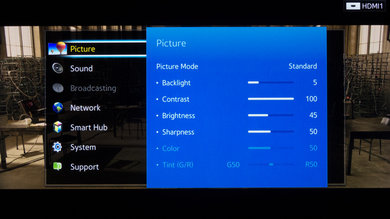- Table of Contents
- Top
- General Settings
- Discussions
General Settings
The input lag was lower when the input type was set to PC on the Samsung HU8550, but it was still high. Setting to PC also helps to create a more natural picture, because it disables most of the software-side processing of the picture.
The default settings were good in the Standard picture mode. Don't forget to use the backlight setting instead of the brightness to adjust the luminosity of the screen. Also, if you want complete control over luminosity, you need to disable the ECO feature under the System tab.
In the advanced settings menu, you don't have much choice, because all the options are grayed out due to the input type being set to PC.
As for the white balance, it was almost perfect by default, but we had to lower the green on the bright side a bit.
As with most Samsung LED TVs, the Warm2 color tone was the closest to the D6500 standard. For those wondering about what the Smart LED feature does, it is the local dimming function. However, because this LED is edge lit (LEDs only on the sides of the TV), this isn't very effective, so we prefer it off (otherwise, it reduces the brightness of large portions of the TV, regardless of whether something is displayed there).

















































